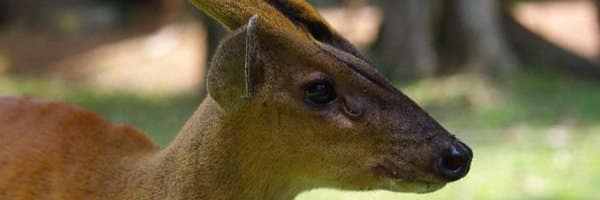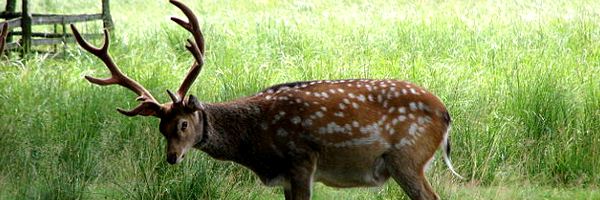Common Muntjac or Indian Muntjac – Muntiacus muntjak
The Common Muntjac Deer is also often referred to as the Indian Muntjac Deer. They are the same though but many people assume they are two different species. They have a brownish color to them and a bulky body. However, they have short stocky legs so the overall structure along with a small head resembles that of a cow in many ways.
They males form very small antlers that feature just one branch to them. The also form canine teeth that are very sharp and look like small tusks. They use those for defending themselves along with the antlers.
Common Muntjac Distribution
They are found spread out around Southeast Asia. They live both on the savannah plains and in the grasslands. They love the tropical forest areas as well. They can move back and forth when they are looking for food versus when they are looking for shelter. Some of them do reside in the hilly areas of the Himalayas. They have to stay very close to water at all times.
Common Muntjac Behavior
Barking sounds are heard coming from the Common Muntjac Deer. Generally this is offered as a warning to others that there may be a predator in the area. It isn’t long after the barking sounds start that any deer in the area will head off for shelter. They can continue to bark though for extended periods of time. This is why they have been nicknamed the Barking Deer.
They are very alert animals and they don’t seem to want to be in dangerous situations. In fact, their barking is also believed to be a mechanism that allows them to stay away from predators. It can be confusing to a predator for such an animal to be barking. They may become confused and decide to seek their next meal elsewhere.
The males are very territorial all the time, not just when they are looking for mates which is often the case with other deer species. They will fight among themselves for territory using thief antlers. This makes it very hard for the young males that are out on their own to be able to find themselves a territory to stake a claim on. They don’t seem to mind if their territory overlaps with a female or two unless they are struggling to find enough food for survival.
Common Muntjac Feeding
They are omnivores rather than herbivores like other species of deer. Some of the foods they consume include fruits, shoots, seeds, and bird eggs. They will consume some types of small animals as well. Their large canines help them with capturing the small animals and consuming them with ease.
Common Muntjac Reproduction
Females are ready for mating when they are approximately 1 year of age. The males will fight viciously for the right to mate with a harem of females. He can have a group of up to six of them. they don’t seem to have a specific breeding season though. As long as food is plentiful it can trigger this process to occur a couple of times per year.
Once mating has occurred it can be about six months before the young offspring are born. Usually only one is born at a time but twins can occur. They will leave their mother to care for their own needs when they are only about six months old.
Common Muntjac Conservation
Their exact numbers aren’t known due to the fact that they are so scattered out there. However, it isn’t believed that they are in any danger of not being able to survive. There isn’t any conservation efforts in place for them. Hunting does occur but not to an extreme for this species of deer. They seem to adapt well to changes in the environment too so they continue to have a decent population.







